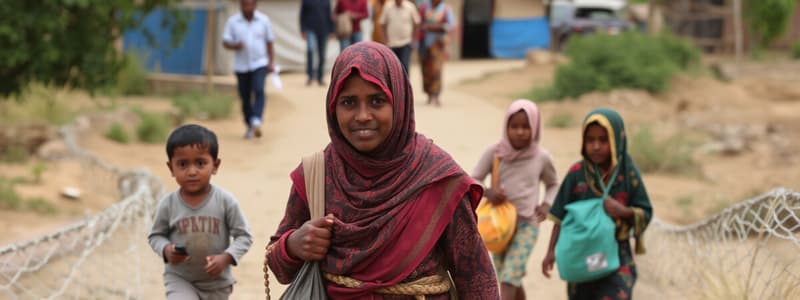Podcast
Questions and Answers
Match the following terms with their definitions:
Match the following terms with their definitions:
Epigenetic inheritance = Transmission of traits not involving DNA sequence changes Behavioral transmission = Acquisition of traits through cultural means Paramutation = Heritable changes in the epigenome across generations Cultural transmission = Passing down learned behaviors, values, and beliefs
Match the following studies with their findings:
Match the following studies with their findings:
Dutch Famine Birth Cohort Study = Children born during famine were smaller than average Morgan and Whitelaw (2008) = Review of human epigenetic inheritance evidence Cunha and Heckman (2007) = Emphasizes the relevance of epigenetics in economics Stein and Lumey (2002) = Failed to reproduce findings from previous famine study
Match the following concepts with their implications:
Match the following concepts with their implications:
Genetic transmission = Inheriting traits through DNA Epigenetic changes = Rapid changes in populations not due to genetic selection Cultural inheritance = Influence of environment on trait acquisition Interaction between genetics and epigenetics = Complex understanding of biological inheritance
Match the following authors with their contributions:
Match the following authors with their contributions:
Match the following authors with their main findings regarding population and development:
Match the following authors with their main findings regarding population and development:
Match the following concepts with their explanations as mentioned in the text:
Match the following concepts with their explanations as mentioned in the text:
Match the following definitions with their terms:
Match the following definitions with their terms:
Match the following terms with their contextual importance in development:
Match the following terms with their contextual importance in development:
Match the following effects with their explanations:
Match the following effects with their explanations:
Match the following effects with their corresponding conditions:
Match the following effects with their corresponding conditions:
Match the following terms with their characteristics:
Match the following terms with their characteristics:
Match the following concepts with their interrelations:
Match the following concepts with their interrelations:
Match the following outcomes with their associated attributes:
Match the following outcomes with their associated attributes:
Match the following research approaches with their focus areas:
Match the following research approaches with their focus areas:
Match the following statements regarding colonial effects with their corresponding descriptions:
Match the following statements regarding colonial effects with their corresponding descriptions:
Match the following relationships with their significance in economic development:
Match the following relationships with their significance in economic development:
Match the authors with their main contributions regarding fertility strategies and the Industrial Revolution:
Match the authors with their main contributions regarding fertility strategies and the Industrial Revolution:
Match the strategies with their definitions:
Match the strategies with their definitions:
Match the concepts with their implications:
Match the concepts with their implications:
Match the terms with their context within the pre-industrial world:
Match the terms with their context within the pre-industrial world:
Match the key points to their corresponding authors:
Match the key points to their corresponding authors:
Match the type of trait transmission with its characteristics:
Match the type of trait transmission with its characteristics:
Match the historical contexts with their developments:
Match the historical contexts with their developments:
Match the author to their key theories or findings:
Match the author to their key theories or findings:
Match the following locations with their respective genetic diversity status:
Match the following locations with their respective genetic diversity status:
Match the authors with their key arguments regarding genetic diversity and economic development:
Match the authors with their key arguments regarding genetic diversity and economic development:
Match the terms with their descriptions:
Match the terms with their descriptions:
Match the populations with their characteristics regarding genetic diversity:
Match the populations with their characteristics regarding genetic diversity:
Match the concepts with their implications for productivity:
Match the concepts with their implications for productivity:
Match the types of societies with their respective characteristics:
Match the types of societies with their respective characteristics:
Match the historical time frame with its significance in development outcomes:
Match the historical time frame with its significance in development outcomes:
Match the factors affecting economic development with their related aspects:
Match the factors affecting economic development with their related aspects:
Match the following researchers with their main focus in genetic and cultural diversity:
Match the following researchers with their main focus in genetic and cultural diversity:
Match the quadrants with their corresponding trade-offs discussed by Ashraf and Galor:
Match the quadrants with their corresponding trade-offs discussed by Ashraf and Galor:
Match the developments in economic theory with their proponents:
Match the developments in economic theory with their proponents:
Match the key concepts with their descriptions:
Match the key concepts with their descriptions:
Match the year with its related analysis or claim:
Match the year with its related analysis or claim:
Match the economic development theories to their authors:
Match the economic development theories to their authors:
Match the economic characteristics with their implications as discussed:
Match the economic characteristics with their implications as discussed:
Match the influence of genetic and cultural diversity on society:
Match the influence of genetic and cultural diversity on society:
Flashcards are hidden until you start studying
Study Notes
Development Drivers
- Putterman and Weil emphasize that development is influenced by traits of human populations, not solely by geography or institutions.
- Migrating populations brought particular traits that affected their economic success.
- Long-term familiarity with institutions and cultural norms plays a crucial role in comparative development.
Impact of European Ancestry
- William Easterly and Ross Levine confirm that a significant population of European ancestry boosts development.
- Data from European settlement during colonization indicates a correlation between European population share and current income per capita.
- The positive impact of European ancestry remains significant even in non-settler colonies with low European presence and poor institutional conditions.
- Historical factors, like agricultural practices and state history, also influence contemporary development independently of European ancestry.
Genetic and Epigenetic Transmission
- Genetic transmission, alongside cultural transmission, shapes inherited traits in populations, influencing behaviors and social norms.
- Epigenetic inheritance systems may enable rapid changes across generations, allowing adaptations that cannot be explained by traditional genetic mechanisms.
- Evidence exists of intergenerationally transmitted traits affecting behavior, as seen in fertility strategies influencing economic outcomes.
Malthusian Trap and Industrial Revolution
- The historical Malthusian trap limited economic growth; however, productivity improvements resulted in population expansions instead of increased per capita income.
- Selective pressures favored traits related to parental investment, leading to a transition out of the Malthusian trap and contributing to the Industrial Revolution.
- Galor and Moav argue that both genetic and cultural traits can influence economic development and demographic trends significantly.
Genetic Diversity and Economic Outcomes
- Gregory Clark highlights the decline of genetic diversity as populations expanded beyond their ancestral origins, suggesting a relationship between this diversity and economic success.
- Intermediate levels of genetic diversity are viewed as ideal for economic development, balancing costs (reduced trust) and benefits (productivity from specialized skills).
- Ashraf and Galor discuss the benefits of genetic heterogeneity, which can lead to increased productivity within diverse labor forces.
Cultural Traits and Development
- Cultural transmission significantly impacts development, with traits like trust and individualism linked to variations in institutional strength and thereby economic outcomes.
- Guido Tabellini's studies explore how cultural attributes can cause differences in economic development, particularly within European regions.
- A broader understanding of how both genetic and cultural traits interact can enhance insights into institutional and economic development dynamics.
Studying That Suits You
Use AI to generate personalized quizzes and flashcards to suit your learning preferences.




